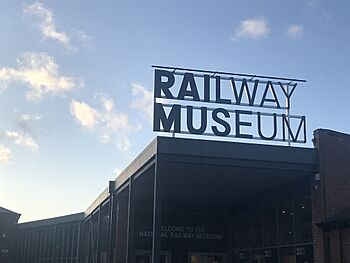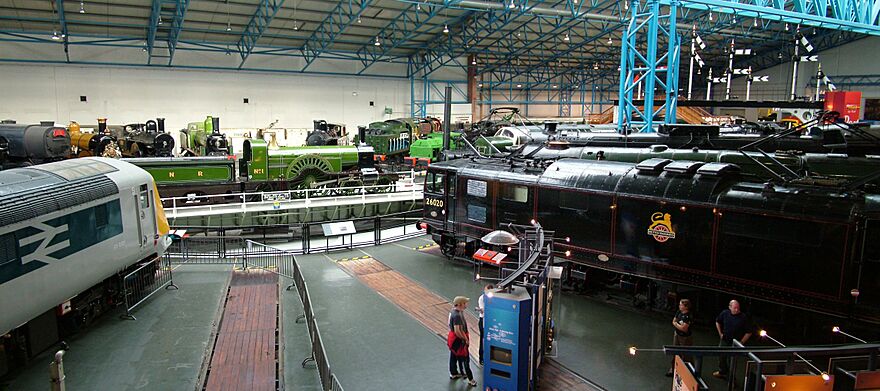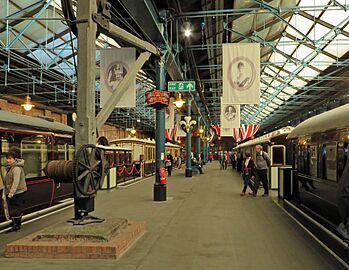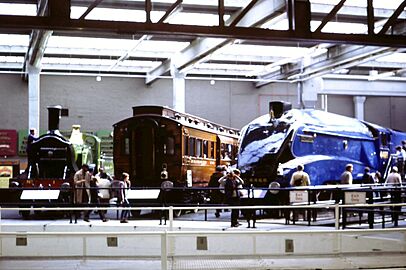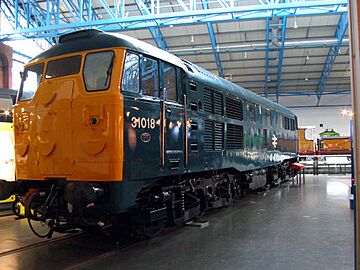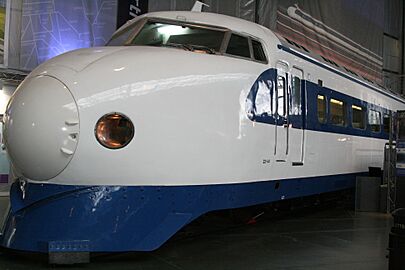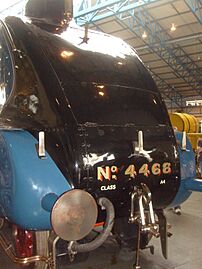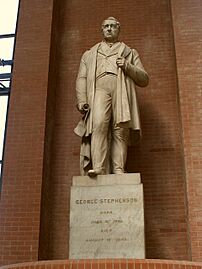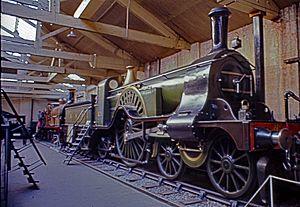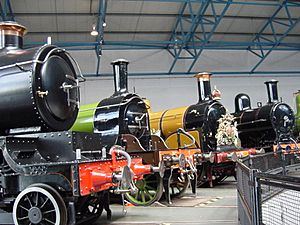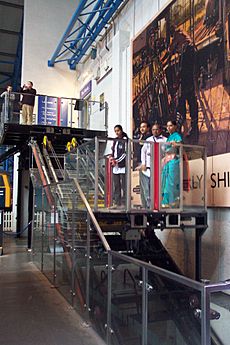National Railway Museum facts for kids
|
|
|
| Lua error in Module:Location_map at line 420: attempt to index field 'wikibase' (a nil value). | |
| Established | 1975 |
|---|---|
| Location | Leeman Road, York, England |
| Type | Railway museum |
| Visitors | 714,379 (2019) |
| National Museum of Science and Industry | |
| National Media Museum · National Railway Museum (Shildon Locomotion Museum) · Science Museum (Dana Centre, Science Museum Swindon) | |
The National Railway Museum (NRM) in York, England, is a super cool place that tells the amazing story of trains in Britain. It's part of the Science Museum Group. This museum is home to a huge collection of important railway vehicles. You can see famous trains like the Mallard, the Stirling Single, the Duchess of Hamilton, and even a Japanese bullet train!
Besides the big trains, the museum has lots of other interesting things. These range from an old recipe book used in George Stephenson's house to films about a "never-stop railway". This special railway was made for the British Empire Exhibition. The National Railway Museum has won many awards, including the European Museum of the Year Award in 2001.
Since 2019, the museum has been undergoing a big makeover. As part of the York Central project, a new entrance building was constructed. This building connects the two separate parts of the museum. The area around the museum was also updated to create new public spaces. In 2020, the design for the museum's new £16.5 million Central Hall building was chosen. This building is a key part of the museum's Vision 2025 plan. The museum's Station Hall, an old goods station from 1875–77, was closed in January 2023 for important repairs. This included putting on a new roof. It is expected to reopen in September 2025.
Discover the National Railway Museum
The National Railway Museum has over 6,000 items on display. About 100 of these are locomotives or other railway vehicles. They all help tell the exciting story of Britain's railway inventions. The collection also includes unique items like fancy jewellery worn by "railway queens" and models of planes, boats, and hovercraft. You can even see experimental machines like Louis Brennan's Gyroscopic Mono-rail car.
This museum is the biggest of its kind in Britain. It welcomed 782,000 visitors in 2018/19. The National Railway Museum first opened in 1975 at its current location. This spot used to be the York North locomotive depot. The museum brought together collections from the former British Railways in Clapham and the old York Railway Museum. Since then, the collection has continued to grow.
You can easily walk to the museum from York railway station. A special "roadtrain" also runs from the city centre (near York Minster) to the museum on Leeman Road during school holidays and summer. Admission to the museum has been free since 2001. It is open daily from 10 am to 5 pm during the February half-term holiday. After that, it's open Wednesday to Sunday from 10 am to 5 pm.
Locomotion, which is the National Railway Museum in Shildon, County Durham, opened in October 2004. The NRM runs it with Durham County Council. Locomotion displays more of the National Collection in a new building. It also uses a historic site around the old workshop of Timothy Hackworth.
-
Class 31 No. 31018 on display in the Great Hall (2006)
-
Statue of George Stephenson in the Great Hall
Amazing Train Collection
The National Collection has about 280 rail vehicles. Around 100 of these are usually at York. The rest are at Locomotion or other museums and heritage railways. The oldest vehicles are from around 1815.
A special part of the display is "Palaces on Wheels". This is a collection of Royal Train carriages. You can see ones used by Queen Victoria and Queen Elizabeth II. These were some of the first rail vehicles ever saved for history.
Other important trains you can usually see at York include the 1846 Furness Railway No. 3 "Coppernob" locomotive. There are also famous express passenger steam locomotives. These include London and North Eastern Railway Class A3 No. 4472 Flying Scotsman (added in 2004). You can also see its sleek sister Class A4 No. 4468 Mallard. Another highlight is the London, Midland and Scottish Railway Princess Coronation Class No. 6229 Duchess of Hamilton. Flying Scotsman sometimes even runs on the main National Rail network!
The museum has also brought in some big trains from other countries. The Chinese Class KF7 4-8-4 locomotive was given to the museum in 1981. It was actually built in Britain. The Wagons-Lits sleeping car was donated in 1980. It was used on the Paris-London Night Ferry service. The only train not connected to Britain is the Japanese 0 Series Shinkansen (bullet train). It was given to the museum by the West Japan Railway Company in 2001. It's now part of an award-winning display. It's one of only two Shinkansen trains outside Japan!
Trains on display are sometimes swapped with other places. New trains from today's railway industry also visit the museum for short times.
Other large exhibits include the Stockton and Darlington Railway Gaunless Bridge. There are also several big winding engines. These were used on railway slopes.
The collection also has many smaller items. These include signalling equipment, road vehicles, ship models, posters, drawings, and other artwork. You can see tickets, train nameplates, staff uniforms, clocks, and watches. There's also furniture and equipment from railway companies' hotels and offices. The museum has a wide range of models. Some of these are operated on the museum's O scale model railway.
Research and Archives: Search Engine
The National Railway Museum has a large library and archive about railways. This includes a very important collection of engineering drawings for locomotives and other vehicles. Copies of these drawings are sold to help with new train building and restoration projects. They are also sold to model makers.
The library has over 20,000 books and 800 journals. About 300 of these are still being published. The archive also has many technical and test records. It holds timetables, including many Bradshaw timetables. The archives also have about 1.75 million photographs. These cover everything from the earliest days of photography to today. They include official collections from railway companies and photos from enthusiasts.
In 1999/2000, the museum started collecting recordings of former railway staff. This created a National Archive of Railway Oral History. It also holds recordings of steam trains by Peter Handford. In 2009, The Forsythe Collection of travel items was added. Many of the museum's artworks and posters can be seen through Search Engine. They are now shown in temporary exhibitions in the museum's art gallery, which opened in 2011.
The Search Engine facility opened in late 2007. It is open from 10:00 am to 5:30 pm, Wednesday to Saturday. You can view the archive and library collections without an appointment. However, the website suggests booking archive materials at least 24 hours ahead. Most of its collections are listed on its website. This lets people see what's available before they visit. If you can't visit, the museum offers a research service called Inreach.
How the Museum Started
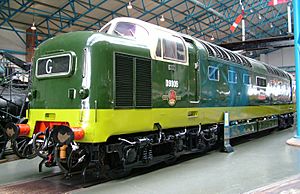
People tried to create a national railway museum since the late 1800s. But the National Collection we have today came from two main efforts. One was by state museums, focusing on new technology. The other was by the railway industry itself. The North Eastern Railway played a big part, as they followed the historic Stockton and Darlington Railway.
The Science Museum collection began in the 1860s. It included early trains like Puffing Billy, Stephenson's Rocket, and Agenoria.
Railway companies sometimes saved old equipment by chance. Some items were stored in workshops or offices. Others were put on public display, often at railway stations. These were usually in a glass case or on a stand.
The first railway museums opened in Norway (1896) and Germany (1899). This made people in Britain talk about doing the same. But nothing happened until much later. Sadly, some early trains were even cut up because there wasn't enough space to keep them.
From 1880, J. B. Harper of the North Eastern Railway collected many items. Much of this was shown at the Stockton & Darlington Railway's 100th birthday in 1925. This collection then became the basis for a museum opened in York in 1928.
The smaller items were in old station buildings. The trains and other large items were in the old locomotive repair shops. But the trains were displayed on short tracks, like statues. It wasn't until the NRM was formed that Britain got a railway museum where big trains could easily move in and out.
The collection was mostly from the North Eastern Railway and Great Northern Railway. The other three 'Big Four' railway companies didn't show much interest at first. But eventually, one train from each did arrive.
The nationalisation of British Railways in 1948 allowed for a more organised approach. A report in 1951 suggested keeping the York museum. It also suggested creating a large museum in London. The Museum of British Transport opened in 1961 in a former bus garage in Clapham.
A list of trains to be saved was made. Many were stored in sheds and workshops. Others were loaned to local museums. The 'Steam' Museum at Swindon still shows many items from the National Collection.
The Beeching Report suggested that British Rail should stop running museums. So, a campaign started to create a new museum. An agreement was reached in 1968. British Rail would provide a building for a National Railway Museum. This museum would be a part of the National Museum of Science and Industry. It became the first English national museum outside London.
The building provided was the old locomotive roundhouse at York North. It was next to the East Coast Main Line. The old museums at York and Clapham closed in 1973. Some items from London went to the London Transport Museum. Some from York went to the Head of Steam museum in Darlington. Trains from these museums, plus others from storage, were moved to the new site and restored.
Growing the Collection (1975–2000)
The museum was opened by Prince Philip, Duke of Edinburgh, in 1975. This happened at the same time as the 150th anniversary of the Stockton & Darlington Railway. Several working trains were shown for this event. The new museum showed more regular passenger coaches and non-steam trains. A popular new exhibit was the ex-Southern Railway Merchant Navy Class No. 35029 Ellerman Lines. This train was cut open to show how a steam locomotive works. The new museum had over a million visitors in its first year!
In 1979, the museum restored a train to celebrate 100 years of food service on trains. They also had an exhibition for 100 years of railway electric traction. This showed off the museum's important electric train collection.
Also in 1979, the museum ordered a working copy of Stephenson's Rocket. This was for the 150th anniversary of the Liverpool and Manchester Railway the next year. This replica has since been shown at events all over the world.
Another working replica was added in 1985. This was for the 150th anniversary of the Great Western Railway. It was a copy of the 7 ft (2,134 mm) broad gauge locomotive Iron Duke.
In 1990, The Rev. W. Awdry's Railway Series Thomas the Tank Engine books became a permanent part of the NRM's collection. This was because they helped keep children interested in railways. In 1991, Christopher Awdry wrote about this in Thomas and the Great Railway Show. In the story, Thomas was made an honorary member of the NRM collection.
Concerns about the roof of the main building led to big changes in 1990. To keep the museum open in York, the old goods depot across Leeman Road was used. This building was already a museum store. It was set up to display trains like a passenger station. This area was called The Great Railway Show. Other exhibits were shown as the National Railway Museum on Tour.
Meanwhile, the main building got a new roof and was rebuilt. It kept only one of its two original 1954 turntables.
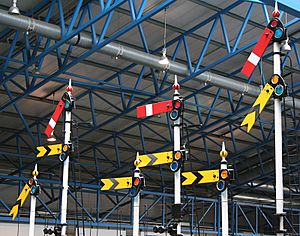
The main building reopened on April 16, 1992, as the Great Hall. This allowed for bigger items to be displayed. These included railway signals, a footbridge from Percy Main station, and a piece from the Channel Tunnel. The old goods shed display stayed as the Station Hall.
In 1995, the museum teamed up with the University of York. They created a research centre called the Institute of Railway Studies (and Transport History). It has also partnered with York College to create the Yorkshire Rail Academy. This teaches practical skills. The museum also offers engineering apprenticeships.
In 1996, the Museum Garden was created. It includes a 7 1⁄4 in (184 mm) gauge ridable miniature railway. A playground was also added.
Concerns about the remaining 1950s buildings led to them being replaced by The Works in 1999. This new area has several parts. The Workshop is for maintaining trains. The Workshop Gallery lets visitors watch this work from above. The Working Railway Gallery shows how railways operate today. It has a balcony overlooking York railway station with live feeds from the station's control centre. The Warehouse is an open storage area. It has become very popular with visitors and museum experts.
Modern Museum Updates
To help visitors move between floors, the Museum Inclinator was built. This was like a small funicular railway. Its parts were visible, showing how it worked. It stopped working because of a lack of spare parts. It was removed by August 2013.
Several big things happened at the museum in 2004. Many railway anniversaries were celebrated with a huge "Railfest". Another Railfest took place from May 25 to 30, 2008, with a 1960s theme. The Locomotion museum opened in Shildon, County Durham. This provided covered space for more trains from the museum's collection. The museum also had a big campaign to buy Flying Scotsman. It arrived at the Museum at the end of Railfest.
The first part of a new centre for the museum's Library and Archives, called "Search Engine", opened in late 2007.
From July 18 to August 23, 2008, the York Theatre Royal put on a popular play at the Museum. It was E. Nesbit's The Railway Children. It was a big success and was repeated in 2009. The museum also provided trains for later shows at Waterloo International station and in Toronto.
Big plans called "NRM+" were made to update the Great Hall display. However, these plans were cancelled in April 2011 due to funding issues. But major changes to the displays in the Station Hall did begin later in 2011.
In 2012, the NRM decided to bring two LNER A4 class steam locomotives back temporarily. These were numbers 60008 Dwight D Eisenhower and 60010 Dominion of Canada. They came from North America for the 'Mallard 75' event in 2013. The locomotives were on loan for up to two years. During this time, they were restored to look their best.
The same year, the NRM created an iPhone App with East Coast. This app let people traveling between London and Edinburgh see museum items related to places along the route. It has since been removed from the App Store.
On December 8, 2012, it was announced that a new part of the National Railway Museum would be built near Leicester North station. This is on the Great Central Railway.
Funding Challenges
In June 2013, the York Press reported that the NRM was facing money problems. This was due to possible budget cuts for the Science Museum Group. The museum considered reducing its activities, bringing back admission fees, or even closing. However, after a campaign by local people, the Chancellor George Osborne announced a smaller budget cut. This led the Science Museum Group director to say that the museum had been saved.
Museum Activities and Awards
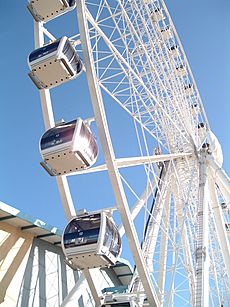
Some people have said that the museum doesn't focus enough on modern trains. Others have said it cares more about making money than about learning. The museum explains that it has financial limits. Its funding from the government is less than for similar museums in London. For some of its money, the museum relies on events like the Yorkshire Wheel. This operated at the museum from 2006 to 2008. Visits from Thomas the Tank Engine also help. The museum has also had a few items stolen.
The museum can receive items from the railway industry through the Railway Heritage Committee. Because there are so many different types of items, deciding what new things to add to the collection can be hard. In the past, the museum treated its trains as if they were still in service. This meant they could be repaired many times. Many of the museum's trains have run on main lines or heritage railways. More recently, the museum has focused on less intense ways of preserving items. This means some exhibits might not run anymore.
The museum's handling of the long repair of LNER Class A3 4472 Flying Scotsman was criticised in a report in 2012.
Since 1977, the Friends of the National Railway Museum group has supported the museum. They provide money and other help. For example, they helped pay for the original restoration of Duchess of Hamilton to run again.
The 1990 "Great Railway Show" won the Museum of the Year award. In 2001, the museum won the European Museum of the Year Award. It has also won White Rose awards from the Yorkshire Tourist Board. In 2004, it received the Heritage Railway Association's Peter Manisty Award for its major developments.
Online World of the Museum
The National Railway Museum website helps visitors plan their trip. The museum also wants to make its collections easier to access online. It has put some recordings from the National Archive of Railway History on its website. The museum's archives and library service, Search Engine, is making more of its collection available online. They provide catalogues and lists for researchers. They also add low-resolution copies of their drawings online. You can search the library collection through the University of York library catalogue. All of the museum's trains and many other items have also been added to the website.
The National Railway Museum is also on other websites. You can order copies of many of its posters, photos, and artworks through the Science and Society Picture Library. The National Railway Museum has a presence on the National Preservation forums. Members can talk directly to museum staff. This provides helpful feedback and information for the museum. Museum staff also write a blog on WordPress.com. They share stories about what happens behind the scenes, like conservation work or preparing for big events.
Famous Locomotives at the Museum
Here are some of the amazing locomotives you might see at the Museum:
- Trains that can run (Operational steam locomotives)
- SR Schools class 4-4-0 No. 925 Cheltenham. It is currently working on the Mid Hants Railway.
- LNER Class A3 4-6-2 60103 Flying Scotsman. Its big repair started in 2006 and was finished in 2016. It stopped running in early 2022 for another repair. It was back in action for its 100th birthday in 2023!
- Trains being repaired or stored (Steam locomotives under overhaul/stored)
- SR Lord Nelson Class 4-6-0 No. 850 Lord Nelson. It is currently working on the Mid Hants Railway.
- SR N15 Class 4-6-0 No. 30777 Sir Lamiel. It is currently being repaired at the Great Central Railway.
- Great Central Railway O4 Class 2-8-0 No. 63601. It is currently at the Great Central Railway. It stopped running in 2012 for repairs.
- British Railways Standard Class 7 "Britannia" 4-6-2 70013 Oliver Cromwell. It was repaired between 2004 and 2008. It is currently at Loughborough for another repair.
- Trains on display (Steam locomotives on static display)
- Stephenson's 0-2-2 Rocket. Two copies are also in the York collection. One can run, and one is cut open to show its parts. The original was at the Science Museum in London until 2018.
- NER No. 66 Aerolite. It has been on display in York since 1934.
- GWR 4000 Class 4-6-0 4003 Lode Star. It returned to the NRM in November 2015.
- LMS Stanier Class 5 4-6-0 5000. It is on static display.
- LNWR Class G2 ("Super D") 0-8-0 No. 49395. It is currently at Locomotion, Shildon, on display.
- LNER Class A4 4-6-2 4468 Mallard. It ran for a while from 1986. Now it's on display and probably won't run again.
- SR Class Q1 0-6-0 No. C1. It is on static display. It might return to the Bluebell Railway to run again.
- BR Standard Class 9F 2-10-0 92220 Evening Star. This was the last steam train built for British Railways. It is on display and not expected to run again. It returned to York in 2010.
- LMS Princess Coronation Class 4-6-2 6229 Duchess of Hamilton. It returned to the NRM in 2009 after being made sleek again.
- Trains located away from York (Steam locomotives located away from York)
- GWR 3700 Class 4-4-0 3440 City of Truro. It was loaned to the Museum of the Great Western Railway in November 2015.
- GWR 6000 Class 4-6-0 6000 King George V. It was loaned to the Museum of the Great Western Railway in November 2015.
- LNER Class V2 2-6-2 4771 Green Arrow. After many years of running, it stopped working in 2008. It needs big repairs. It is currently at Doncaster Museum and Art Gallery.
Museum Leaders
| Head | Served |
|---|---|
| John A. Coiley | 1974–1992 |
| Andrew Dow | 1992–1994 |
| Andrew J. Scott | 1994–2010 |
| Steve Davies | 2010–2012 |
| Paul Kirkman, civil servant with the Department for Culture, Media and Sport | 2012–2017 |
| Judith McNicol | 2017– |
See also
 In Spanish: Museo Nacional del Ferrocarril de York para niños
In Spanish: Museo Nacional del Ferrocarril de York para niños
- List of British railway museums
- List of railway museums worldwide
- Kyoto Railway Museum


